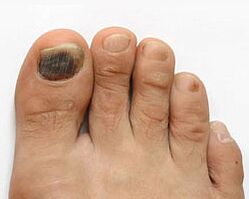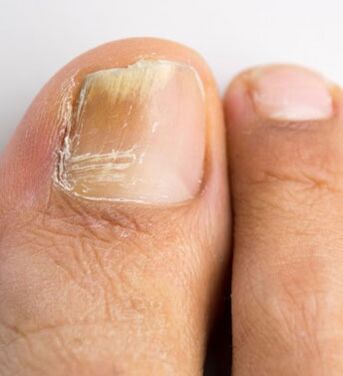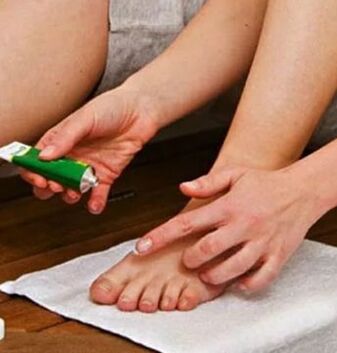
Fungal diseases are often diagnosed in dermatology. Walking barefoot on the beach, going to the sauna, trying on other people's shoes, boots, etc. , without changing shoes leads to widespread toe disease. According to statistics, the most common damage to the nail plate starts from the thumb. This is due to the specificity of the nail anatomy and the significant subungual space. If prompt medical help is sought, this disease does not cause much discomfort, but is only a temporary cosmetic defect.
symptoms of disease
Going under the nail plate, the fungal infection quickly finds a nutrient medium for itself and begins to multiply actively. During this time, a person may experience no symptoms, or mild itching and redness in the nail area. In addition, the growth of pathogen colonies leads to more visible signs, which is a reason to seek advice from a medical facility. Many unpleasant complications can be avoided if nail fungus on the big toe is treated early on. The main symptoms include:
- changes in nail color;
- Spots appear under it;
- lack of natural shine;
- increase vulnerability;
- Nail deformities.
The longer the disease is left untreated, the greater the negative effects of the fungus: the body of the nail thickens and its shape changes considerably. Such fingers can cause pain when trying to wear tight shoes or accidental mechanical injury. In the future, the nail will completely lose its healthy appearance, collapse, fall off, and possibly fall off the nail bed.
Causes of mold on the big toe
The causative agent of the disease is three groups of pathogenic fungi: yeast-like fungi, molds and dermatophytes. Their prevalence in the environment is extremely high, so there may be multiple modes of infection. However, not everyone will become infected from dangerous contact, as immunity protects health. People with reduced resistance to this infection often need treatment for the fungus on the big toe. In addition, the disease can be caused by:

- thumb is often injured;
- does not meet hygiene standards;
- the presence of fungal skin lesions;
- diabetes;
- overweight;
- vascular disease;
- Varicose veins of lower extremities.
Weak immunity occupies a special place in the predisposing factors. Past viral infections, frequent colds, sore throats, poisoning can rob the body of defenses against fungal infections and increase the risk of infection. In addition, lack of nutrition, frequent cracks and other injuries in the big toe area, can reduce local immunity and cause disease.
Which doctor should I contact?
If you start to worry about any unpleasant symptoms related to your toenails, you should seek medical attention as soon as possible. Itching, redness, and discoloration may indicate impending disease. A doctor will provide qualified assistance in this matter.
He specializes in a variety of skin conditions and will help with nail fungus on the big toe. First, a thorough diagnosis is made, including taking a medical history, examining, and passing some laboratory tests. To more fully assess the patient's condition, the dermatologist can set several additional question:
question:
- How often do you notice changes in your nails?
- What is the first thing to worry about?
- Is your nail plate discolored?
- How long does it take to change the form?
- What activity are you doing?
- Do you often go to the sauna?
- Have you ever had a fungal infection in your body?
After passing additional tests, the patient needs to see a dermatologist again. Based on the results obtained and the clinical situation, the doctor prescribes the treatment of the disease.
treat
The effectiveness and duration of disease treatment depends directly on early seeking medical help and the correct regimen. In the initial stages of the disease, topical ointments and gels containing antifungal ingredients are effective means. In this case, it is important to correctly identify the pathogen and deal with it. Other treatments are also possible:
- complex treatment;
- physiotherapy effect;
- Laser Treatment;
- nail removal;
- Eliminate comorbidities.
In more complex pathological cases, an integrated approach is shown, including topical and internal use of antifungal drugs, general supplements. An adjunct to drug therapy is a low-sugar diet. It was he who created favorable conditions for the reproduction of parasitic fungi. For a faster recovery process, we recommend:
- take a vitamin complex;
- lead an active lifestyle;
- Perform daily disinfection procedures;
- Strictly follow the treatment plan;
- Say goodbye to bad habits.
An important part of the final stage of treatment measures is prevention of relapse and enhancement of immunity. Patients are not advised to walk barefoot on the beach, not to try on other people's shoes, and not to make their feet sweat frequently.
possible complications
Aesthetic flaws are far from fungus. In advanced cases, the nail becomes excessively large, extremely painful, and grows into the adjacent skin, possibly with secondary infection and purulent lesions. Treating toenail fungus in such cases will be a long and laborious process. In addition to local negative effects, pathogens have devastating effects on the entire organism, the following are possible:
- allergy;
- dermatitis;
- blood poisoning;
- poisoning;
- Physical disease.
When fungal strains reach large numbers, their waste can turn into poison, poisoning a person and depriving his immune system of defenses. In this state, the possibility of various viral or bacterial lesions is very high. There was a marked deterioration in overall health and performance.















